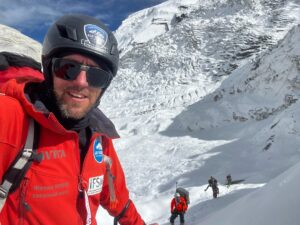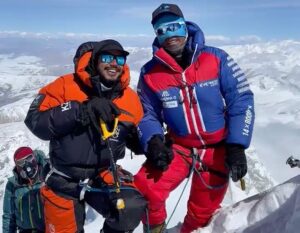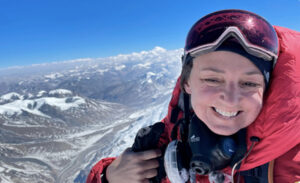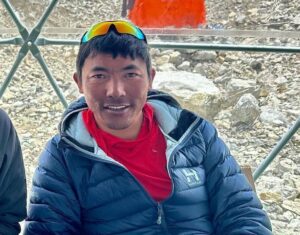There is little information about the spring season in the Himalaya yet, but Tibet’s Shisha Pangma will certainly be a focus of attention. Here, several record-seekers came away empty because of the tragedy that claimed four lives last fall. The deaths prompted the sudden closure of the mountain.

Shisha Pangma in the fall of 2023. Photo: Sasko Kedev
2023: records and tragedy
Last spring, only a handful of climbers were able to score a permit for Shisha Pangma. But that fall, a large number of climbers signed on to climb a peak that had been closed for years because of COVID-related restrictions. For several of them, it had become the last peak in their 14×8,000m quest.
Moreover, an unprecedented number of those 8,000m collectors were pursuing some kind of record (national, age, or speed). In some cases, two or more contenders had come to Tibet after the same record.
This quest for records ultimately led to the tragedy on Oct. 7, when Gina Marie Rzucidlo and Anna Guttu raced each other to become the first U.S. woman to complete the 14×8000’ers. The pair died in two separate avalanches near the summit, along with their sherpa guides, Tenjen Lama and Mingmar Sherpa.
Other Nepalese were injured in the accidents while expedition leader Mingma G suffered bad injuries during the rescue efforts. Other climbers then decided to wait or retreat because of the dangerous conditions on the mountain. Another group only heard the shocking news when they reached Base Camp that day. Overall, around 50 climbers were on the mountain on Oct. 7.

The routes followed and the location of the first (prima) and second (seconda) avalanches on Shishapangma, Oct. 7. Photo/topo courtesy of Mario Vielmo
Forced halt
No one tried to climb Shisha Pangma after that. The China Tibet Mountaineering Association (CMTA) quickly closed the mountain for the rest of the season. Some survivors later shared details about that tragic day. Their words triggered another kind of avalanche: criticism from the worldwide community, including from veteran alpinists who knew the mountain well and who blamed a lack of leadership, little attention to safety and conditions, and poor decision-making for what transpired.
Now time has passed, spring is coming, and the records are still waiting to be broken, many of them by Nepalese nationals.
Leaders, clients after the same goal
Mingma G of Imagine Nepal sustained a broken skull and coccyx after he took a long fall while helping in rescue efforts after the avalanches. Currently training in Europe, he will return to Shisha Pangma in the spring, before heading to Everest’s South Side. If Mingma G succeeds on Shisha Pangma without oxygen, he will become the first Nepalese to summit all 14 8,000’ers without supplementary O2.

Mingma G on the summit of Cho Oyu in the fall of 2023, right before heading for Shisha Pangma. Photo: Mingma G/Facebook
Last year, Mingma G was also competing with Nirmal Purja, although Purja is a UK citizen. Currently, it is not confirmed — but still likely — that Purja’s Elite Exped will put a team on the mountain as well. He and Mingma G joined forces last year, but Mingma G confirms that Imagine Nepal will operate independently this time.
We do not yet know whether Imagine Nepal will have Pakistan’s Sirbaz Khan on the team. Like compatriot Shehrohze Kashif, Khan is just one peak away from becoming the first Pakistani to complete the 14×8,000’ers. Kashif has confirmed that he is returning to Shisha Pangma this spring.
Young Kashif climbs with full support, while Khan subsidizes his climbs by fixing ropes. He has only used supplementary O2 on three peaks. The video below shows Sirbaz Khan on his 12th 8,000’er, Manaslu.
Young climbers
Climbalaya’s Shisha Pangma expedition will start on April 9. They may join forces with their sister companies, Seven Summit Treks and 14 Peaks Expedition. Nima Rinji, the son of Tashi Lakpa Sherpa — who runs 14 Peaks — is at age 18 on track to become the youngest-ever 14×8000’er summiter. He has already bagged 10 out of the 14, and was the youngest summiter on all of them except Everest. He will likely want to tick off Shisha Pangma as soon as possible, before turning to Kangchenjunga, Makalu, and Annapurna.
Also trying to become the youngest, however briefly, are Adrianna Brownlee of the UK and Shehrohze Kashif of Pakistan. Both have only Shisha Pangma to go. Brownlee is 23, anad Khashif will turn 22 by springtime. The Pakistani youngster confirmed to ExplorersWeb that he is determined to finish, although he did not confirm that he will try as early as this spring.
Brownlee told ExplorersWeb that she has not yet made up her mind about returning to Shisha Pangma quite so soon. She is currently focused on AGA, the outfitting company she started with Gelje Sherpa.
Gelje Sherpa was one of 2021’s Winter K2 summiters and finished his own 14×8,000m quest last year on Cho Oyu. Considered one of the best Sherpa climbers in Nepal, his reputation rose to superstar/superman status on Everest last spring when he found a climber abandoned near the summit and carried the man down to safety on his back.
Full support and a safer season
So far, all Shisha Pangma climbers are clients on commercial expeditions, using sherpa support. Regarding supplementary O2: Mingma G didn’t use it on the last few peaks he guided; Adriana Brownlee summited Gasherbrum I last year without it and might try that again.
In the end, though, Chinese authorities will have the last word. On Everest’s North Side this year, they are not permitting individual, no-O2 clients. Whether this will also be the case on Shisha Pangma, in light of last year’s events, is unclear.
Shisha Pangma’s normal route, on the north side of the mountain, is one of the most straightforward climbs on all the 8,000’ers. However, its final slopes are avalanche-prone because of wind slabs formed by the relentless, southern winds. Expert guide and 14×8,000’er summiter Ralf Dujmovits explained the process after the avalanches last year. He wrote:
In spring, the longer, warmer days and the sunshine that hits the slope (even obliquely) help bond the snow and significantly lower the avalanche danger. Of course, there are always exceptional weather conditions at any time of year, but generally speaking, Shisha Pangma is much safer to climb in April-May than it is in September/October. The very cold temperatures of late autumn and the almost complete lack of sunshine on the slope preserve this particular avalanche danger in the snowpack, sometimes for weeks or months.
Tibet not open to everyone
Despite the interest and the relatively easy route, the number of Shisha Pangma permits will be limited. Typically, the CTMA keeps numbers low enough to avoid large crowds. Also, permits and visas are hard to get and involve a complex game of politics and influence that has discouraged some big companies.
One of these is 8K. “There’s a significant Monopoly game involved in getting the China Mountaineering visa and permits,” CEO Lakpa Sherpa told ExplorersWeb. “So we are not prioritizing Tibet and instead focus on providing the best service on our Nepal and Pakistan expeditions.”
The company had some bitter moments last spring when their main sherpa guides, Dawa Ongchu and Pasdawa Sherpa, (who supported Kristin Harila on her first attempt to speed climb the 14×8,000’ers in 2022) had their visas rejected at the last moment. Lakpa (and Pasdawa Sherpa) averred that some “big companies” hampered their attempts to get visas.
Final note: Recovering the 2023 bodies?
Shortly after the fall 2023 avalanches, Kristin Harila of Norway launched an unusual fundraising campaign. She wanted to raise money to recover the bodies of Gina Rzucidlo and Tenjen Lama by air this spring.
Harila had completed her speed project entirely supported by Tenjen Lama. Reportedly, she had also spoken to Rzudcilo’s family, who wanted her body retrieved as well.
However, the initiative was deemed useless or even risky by climbers. Mingma G, who witnessed the avalanches, said that recovery was impossible, as the climbers had been swept into a huge crevasse and buried out of reach.
“It would be better to donate the money to Tenjen’s widow,” he suggested when ExplorersWeb asked him at the Banff Mountain Film Festival about Harila’s plan.
In addition, Harila mentioned that a helicopter would conduct the initial search. This would entail crossing the border into Tibet from Nepal. The idea was that since the deceased climbers had Recco reflectors in their clothing, a helicopter equipped with a Recco detector might pick up the signal.
Few details
There was no further information about how or if the China Tibet Mountaineering Association would allow such flights or any other details about the proposed recovery attempt if a signal was picked up. At the time, Harila’s GoFundMe campaign collected very little money.
Some weeks ago, Harila posted an update: “In spring of this year, weather conditions will be more favorable for a search and repatriate mission,” she wrote. “I have gathered a team, and we are ready to go.”
Still, there are no details about that potential team, any rescue plans or permissions acquired, or a realistic estimate of how possible such a recovery might be. Harila has asked for donations amounting to nearly $300,000. As of today, her campaign has raised about $8,500.
Note that the bodies of the other two fatalities, Anna Gutu and Migmar Sherpa, were not buried in the avalanche that killed them. Their remains were taken to some high camp, and there has been no public information about them since.






